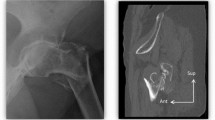Abstract
Introduction
The clinical relevance of classification for trochanteric fractures is limited and little agreement exists on what type of implant should be used. It is unknown whether more advanced radio-diagnostics, such as CT, result in better agreement on the treatment. We assessed the effect of CT on agreement of classification and subsequent treatment for trochanteric fractures.
Materials and methods
Eleven observers (five radiologists, four trauma surgeons and two orthopedic residents) assessed 30 radiographs and CTs of trochanteric fractures. Each rating included an assessment according to the AO classification and of the preferred type of implant. The inter-observer agreement of the AO classification and on the choice of implant was calculated.
Results
The inter-observer agreement was κ0.70 (SE 0.03) for radiographic assessment of the main groups of the AO classification and κ0.68 (SE 0.03) for CT assessment. The agreement on choice of implant was κ0.63 (SE 0.05) if the choice was made with radiographs and κ0.69 (SE 0.05) with CTs. Six out of the 13 fractures were classified differently after assessment of the CT. Most corrections in choice of implant occurred for the assessment of A3 fractures.
Conclusions
This study confirmed that trochanteric fractures can be reliably classified on both radiographs and CT, according to the main groups of the AO classification. The implementation of CT for trochanteric fractures does not lead to higher agreement on fracture classification or choice of treatment. Therefore, the clinical relevance of CT for classification of trochanteric fractures seems low. For specific subgroups such as A3 fractures, CT may be of value for adequate fracture classification and subsequent treatment strategies.


Similar content being viewed by others
References
Avery DM 3rd, Matullo KS (2014) Distal radial traction radiographs: interobserver and intraobserver reliability compared with computed tomography. J Bone Joint Surg Am 96(7):582–588
Barton TM, Gleeson R, Topliss C, Greenwood R, Harries WJ, Chesser TJ (2010) A comparison of the long gamma nail with the sliding hip screw for the treatment of AO/OTA 31-A2 fractures of the proximal part of the femur: a prospective randomized trial. J Bone Joint Surg Am 92(4):792–798
Brammar TJ, Kendrew J, Khan RJ, Parker MJ (2005) Reverse obliquity and transverse fractures of the trochanteric region of the femur; a review of 101 cases. Injury. 36(7):851–857
Chan PS, Klimkiewicz JJ, Luchetti WT, Esterhai JL, Kneeland JB, Dalinka MK, Heppenstall RB (1997) Impact of CT scan on treatment plan and fracture classification of tibial plateau fractures. J Orthop Trauma 11:484–489
Chapman CB, Herrera MF, Binenbaum G, Schweppe M, Staron RB, Feldman F, Rosenwasser MP (2003) Classification of intertrochanteric fractures with computed tomography: a study of intraobserver and interobserver variability and prognostic value. Am J Orthop (Belle Mead NJ) 32(9):443–449
van Embden D, Rhemrev SJ, Meylaerts SA, Roukema GR (2010) The comparison of two classifications for trochanteric femur fractures: the AO/ASIF classification and the Jensen classification. Injury 41(4):377–381
Fleiss JL (1981) Statistical methods for rates and proportions, 2nd edn. Wiley, New York
Haapamaki VV, Kiuru MJ, Koskinen SK (2004) Ankle and foot injuries: analysis of MDCT findings. AJR Am J Roentgenol 183:615–622
Haidukewych GJ, Israel TA, Berry DJ (2001) Reverse obliquity fractures of the intertrochanteric region of the femur. J Bone Joint Surg Am 83-A:643–650
Harness NG, Ring D, Zurakowski D, Harris GJ, Jupiter JB (2006) The influence of three-dimensional computed tomography reconstructions on the characterization and treatment of distal radial fractures. J Bone Joint Surg Am 88(6):1315–1323
Landis JR, Koch GG (1977) The measurement of observer agreement for categorical data. Biometrics 33:159–174
Marsh JL, Slongo TF, Agel J et al (2007) Fracture and dislocation classification compendium—2007: Orthopaedic Trauma Association Classification, Database and Outcomes Committee. J Orthop Trauma 21(Supplement 10):S1–S163
Mustonen AO, Koskinen SK, Kiuru MJ (2005) Acute knee trauma: analysis of multidetector computed tomography findings and comparison with conventional radiography. Acta Radiol 46:866–874
Palm H, Krasheninnikoff M, Holck K, Lemser T, Foss NB, Jacobsen S, Kehlet H, Gebuhr P (2012) A new algorithm for hip fracture surgery. Reoperation rate reduced from 18 to 12 % in 2000 consecutive patients followed for 1 year. Acta Orthop 83(1):26–30
Palm H, Posner E, Ahler-Toftehøj HU, Siesing P, Gylvin S, Aasvang T, Holck K, Holtz KB (2013) High reliability of an algorithm for choice of implants in hip fracture patients. Int Orthop 37(6):1121–1126
Parker MJ, Bowers TR, Pryor GA (2012) Sliding hip screw versus the Targon PF nail in the treatment of trochanteric fractures of the hip: a randomised trial of 600 fractures. J Bone Joint Surg Br 94(3):391–397
Schipper IB, Steyerberg EW, Castelein RM, van Vugt AB (2001) Reliability of the AO/ASIF classification for pertrochanteric femoral fractures. Acta Orthop Scand 72(1):36–41
Shen J, Hu F, Zhang L, Tang P, Bi Z (2013) Preoperative classification assessment reliability and influence on the length of intertrochanteric fracture operations. Int Orthop 37(4):681–687
Shoukri MM, Asyali MH (2004) Sample size requirements for the design of reliability study: review and new results. Stat Methods Med Res 13:251–271
Zeng C, Wang YR, Wei J, Gao SG, Zhang FJ, Sun ZQ, Lei GH (2012) Treatment of trochanteric fractures with proximal femoral nail antirotation or dynamic hip screw systems: a meta-analysis. J Int Med Res 40(3):839–851
Zhu Y, Yang G, Luo CF, Smith WR, Hu CF, Gao H, Zhong B, Zeng BF (2012) Computed tomography-based three-column classification in tibial plateau fractures: introduction of its utility and assessment of its reproducibility. J Trauma Acute Care Surg 73(3):731–737
Acknowledgments
Dr. Ron Wolterbeek for the statistical support.
Author information
Authors and Affiliations
Corresponding author
Ethics declarations
Conflict of interest
No benefits in any form have been received or will be received from a commercial party related directly or indirectly to the subject of this article. No funds were received in support of this study.
Rights and permissions
About this article
Cite this article
van Embden, D., Scheurkogel, M.M., Schipper, I.B. et al. The value of CT compared to radiographs in the classification and treatment plan of trochanteric fractures. Arch Orthop Trauma Surg 136, 1091–1097 (2016). https://doi.org/10.1007/s00402-016-2475-z
Received:
Published:
Issue Date:
DOI: https://doi.org/10.1007/s00402-016-2475-z




